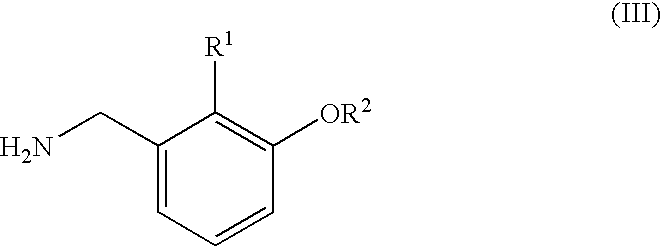Amide compounds and plant disease controlling method using same
- Summary
- Abstract
- Description
- Claims
- Application Information
AI Technical Summary
Benefits of technology
Problems solved by technology
Method used
Image
Examples
preparation example 12
of the Invented Compound
[0239]To a mixture of 0.50 g of N-(3-hydroxyphenyl)methyl-quinoline-6-carboxamide, 0.35 g of 6-bromo-1-hexene and 5 ml of DMF was added 0.88 g of cesium carbonate, and the resulting mixture was stirred at room temperature for 12 hours. Then, water was added to the reaction mixture and the solid precipitated was collected by filtration and washed with water and then hexane to obtain 0.57 g of N-[3-(5-hexenyloxy)phenyl]methyl-quinoline-6-carboxamide (hereinafter referred to as the invented compound (12)).
The Invented Compound (12)
[0240]
[0241]1H-NMR (DMSO-D6) δ: 9.26 (1H, t, J=5.7 Hz), 8.99 (1H, dd, J=4.1, 1.5 Hz), 8.56 (1H, d, J=1.7 Hz), 8.48 (1H, d, J=8.0 Hz), 8.22 (1H, dd, J=8.8, 2.0 Hz), 8.09 (1H, d, J=8.8 Hz), 7.61 (1H, dd, J=8.2, 4.3 Hz), 7.24 (1H, t, J=8.0 Hz), 6.93-6.91 (2H, m), 6.83-6.80 (1H, m), 5.85-5.75 (1H, m), 5.01 (1H, dd, J=17.2, 1.6 Hz), 4.94 (1H, dd, J=10.1, 1.1 Hz), 4.51 (2H, d, J=5.9 Hz), 3.95 (2H, t, J=6.5 Hz), 2.09-2.04 (2H, m), 1.73-1.67 (...
preparation example 13
of the Invented Compound
[0242]To a mixture of 0.30 g of N-(3-hydroxyphenyl)methyl-quinoline-6-carboxamide, 0.23 g of 7-bromo-1-heptene and 4 ml of DMF was added 0.53 g of cesium carbonate, and the resulting mixture was stirred at room temperature for 8 hours. Water was added to the reaction mixture and the solid precipitated was collected by filtration and washed with water and then hexane to obtain 0.35 g of N-[3-(6-heptenyloxy)phenyl]methyl-quinoline-6-carboxamide (hereinafter referred to as the invented compound (13)).
The Invented Compound (13)
[0243]
[0244]1H-NMR (DMSO-D6) δ: 9.26 (1H, t, J=5.9 Hz), 8.99 (1H, dd, J=4.3, 1.6 Hz), 8.56 (1H, d, J=1.7 Hz), 8.48 (1H, d, J=7.6 Hz), 8.22 (1H, dd, J=8.8, 2.0 Hz), 8.09 (1H, d, J=8.8 Hz), 7.62 (1H, dd, J=8.3, 4.1 Hz), 7.24 (1H, t, J=8.2 Hz), 6.93-6.91 (2H, m), 6.82-6.80 (1H, m), 5.83-5.73 (1H, m), 4.99 (1H, dd, J=17.3, 1.5 Hz), 4.92 (1H, dt, J=10.2, 1.0 Hz), 4.51 (2H, d, J=5.9 Hz), 3.94 (2H, t, J=6.5 Hz), 2.04-1.99 (2H, m), 1.73-1.66 (2H, m...
preparation example 14
of the Invented Compound
[0245]To a mixture of 0.30 g of N-(3-hydroxyphenyl)methyl-quinoline-6-carboxamide, 0.25 g of 8-bromo-1-octene and 4 ml of DMF was added 0.33 g of cesium carbonate, and the resulting mixture was stirred at room temperature for 8 hours. Water was added to the reaction mixture and the solid precipitated was collected by filtration and washed with water and then hexane to obtain 0.38 g of N-[3-(7-octenyloxy)phenyl]methyl-quinoline-6-carboxamide (hereinafter referred to as the invented compound (14)).
The Invented Compound (14)
[0246]
[0247]1H-NMR (DMSO-D6) δ: 9.26 (1H, t, J=5.9 Hz), 8.99 (1H, dd, J=4.4, 1.7 Hz), 8.56 (1H, d, J=2.0 Hz), 8.48 (1H, d, J=7.6 Hz), 8.22 (1H, dd, J=8.8, 2.0 Hz), 8.09 (1H, d, J=8.8 Hz), 7.62 (1H, dd, J=8.3, 4.1 Hz), 7.24 (1H, t, J=8.0 Hz), 6.93-6.91 (2H, m), 6.82-6.80 (1H, m), 5.82-5.72 (1H, m), 5.01-4.95 (1H, m), 4.94-4.90 (1H, m), 4.51 (2H, d, J=5.9 Hz), 3.93 (2H, t, J=6.5 Hz), 2.02-1.97 (2H, m), 1.72-1.65 (2H, m), 1.43-1.27 (6H, m).
PUM
 Login to View More
Login to View More Abstract
Description
Claims
Application Information
 Login to View More
Login to View More - R&D
- Intellectual Property
- Life Sciences
- Materials
- Tech Scout
- Unparalleled Data Quality
- Higher Quality Content
- 60% Fewer Hallucinations
Browse by: Latest US Patents, China's latest patents, Technical Efficacy Thesaurus, Application Domain, Technology Topic, Popular Technical Reports.
© 2025 PatSnap. All rights reserved.Legal|Privacy policy|Modern Slavery Act Transparency Statement|Sitemap|About US| Contact US: help@patsnap.com



